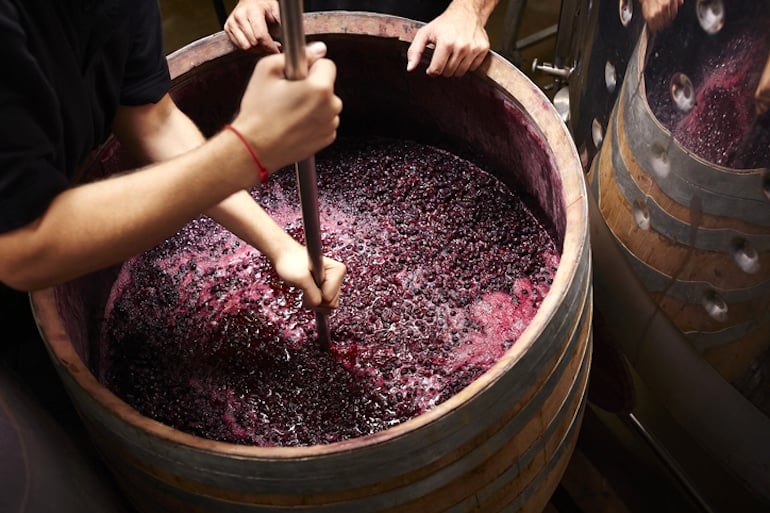THE WELLNEST • Food • Healthy Eating
What Is Natural Wine and Is It Worth Trying?
By Carrie Gabriel, MS, RDN •
May 3, 2021
Wondering what natural wine is? Carrie Gabriel, MS, RDN, takes a look at this niche alcohol trend.
If you’re even the slightest bit of a vino drinker, you’ve probably heard of natural wine. However, you may be thinking: Wait, isn’t all wine natural?
Contrary to what you may believe, not all wine consists purely of grapes and sunshine. Here’s the scoop on what natural wine is, what it tastes like, and how it differs from organic varieties.



What is natural wine?
When it comes to this niche type of wine, a few unique elements set it apart from others. Here’s a quick primer on what makes it “natural”:- it contains minimal preservatives (sometimes including small amounts of sulfites)
- it contains no added yeast
- grapes are handpicked from vineyards and grown under biodynamic or organic circumstances

What does natural wine taste like?
Natural wines aren’t manipulated like conventional wines. The flavors will often be inconsistent from bottle to bottle and may have a “funky” flavor, perhaps resembling cider or vinegar. That’s because the natural winemaking process involves slower fermentation and oxidation (more exposure to oxygen).Does it give you a hangover?
Natural wine is still alcohol—and like other alcohols, you should drink it in moderation. The 2020-2025 Dietary Guidelines for Americans indicates that an upper limit shouldn’t exceed more than five ounces of wine daily for women and 10 ounces for men. Plus, all alcohol is dehydrating—so if you don’t consume enough water and you drink natural wine in excess, you’ll still likely get a hangover.Is natural wine the same as organic wine?
To begin, organic wine is made from grapes grown on an organic farm. Some labels may read “made with organic grapes,” or there may be a certification indicator from the USDA, CCOF (California Certified Organic Farmers), or other overseeing administrations. That said, it’s important to note that organic farming uses organic chemicals and treatments. Therefore, organic wine is not chemical-free. Then, when it comes to natural wine, there’s no universal certification system; independent growers can choose what they feel is best for their wine. That said, many of these brands do choose to limit the use of man-made chemicals, additives, and industrial practices. If it helps, you can compare buying natural wine to shopping the parameters of the grocery store for the less processed, whole food-based items.
Is natural wine better for you?
Due to its minimal (or lack of) additives, natural wine is inherently healthier than its counterparts. Also, since it’s made with sustainably grown grapes, natural wine is also considered to have a more positive impact on the environment. However, there’s a lack of scientific evidence supporting claims of health benefits in natural wine. For that reason, let’s instead discuss conventional wines and how they’re made.Conventional Wine Production
Conventional wines are produced in large volumes. During production, steps are taken to maintain consistency, quality control, and improve shelf life. As Vox reports, along the way:- lab-grown yeast controls fermentation and flavor
- acid helps the wine age better
- some winemakers may add sugar to add more body to the wine
Additives in Conventional Wine
Helping to fuel the natural wine movement is the knowledge that there are over 60 approved additives American winemakers can use in conventional wines—all without having to disclose them on the label. Undeclared additives may include egg whites, fish gelatin, and assorted pesticides. A 2017 study found that 11 pesticides used in conventional winemaking can be detected by taste. These pesticides were first detected in water, then diluted to levels found in wine. Most of these pesticides are classified as endocrine or nervous system disruptors, which researchers suggest can lead to long-term health concerns if consumed regularly.
Where to Buy Natural Wine
Natural wine sales are booming, with a growing number of wine bars and shops—the latter both in-store and online—that stock a variety of options. Online shops like Primal Wine have staff you can reach out to for advice. Plus, you may want to brush up on some terminology. Words like cloudy and funky, cider-like or kombucha-like can help to describe some natural wines. It’s worth noting that starting prices for natural wines can be a bit higher than conventional kinds. A bottle can cost anywhere from 15 dollars to hundreds. Lastly, if you’ve tried natural wine once and didn’t love it, consider trying another. There are a variety of taste profiles out there, and finding your favorite is another part of the fun.More like this









